How different would studying medieval manuscripts be if we could interact with these books like their earliest readers did? Anxieties about how the digital realm structures relations between people and things, both in medieval studies and beyond, give an urgency to this thought experiment. Books, of course, weren’t (and aren’t) just read: they are experienced through the senses, they are made to occupy certain spaces, they exchange hands, they invite interventions that promise to speak to future readers. Their ‘thing power’ is predicated on a tangibility and mobility that threaten to make way in the two dimensions of the digital image. Medievalists often emphasise the acoustic, tactile, and even olfactory qualities of handling parchment. These are sensations that can be approximated, though not fully replicated, in the reading room. There is, however, a set of more corporeal, even ‘dirty’, reading practices that can only be imagined in relation to these heritage objects. A twenty-first-century reader rubbing, scratching, stroking, or kissing a manuscript illumination doesn’t bear thinking about!
Or does it? Kathryn M. Rudy’s ground-breaking research on the traces of tactile interaction left on medieval books has shown, firstly, how pervasive such practices were, and secondly, how they point to a reader’s, or community of readers’, affectively-charged attachment to a text or image and what it represents or embodies. My postdoctoral project, funded by the British Academy and hosted by the MMLL Faculty in Cambridge, considers the stakes of these haptic practices for manuscripts written in medieval French. How do we read these signs of touch? How do we read with these signs of touch?
Assessing the evidence can be tough with manuscripts that survive to us in imperfect, worn states. Knowing where, when, and how a manuscript was touched leads us into hypotheticals and speculation. This is made all the harder by the fact that we can’t ‘have a go’ on an actual medieval book (the horror!), to see how the pigments react to different levels of force and moisture expressed through different motions.
Thanks to the sheer brilliance of Becky Field, a third-year PhD student in the English Faculty trained in medieval illumination, we have the next best thing: a replica of a late-thirteenth century manuscript illumination made on vellum using gold leaf, and pigments and ink produced following medieval recipes. Becky agreed to imitate roughly a miniature from Boulogne-sur-Mer, Bibliothèque Municipale, MS 142, a copy of the so-called Eracles, a French prose translation of William of Tyre’s Chronicle (with continuations). This manuscript was in all likelihood produced in a workshop in Saint-Jean-d’Acre (by the Paris-trained ‘Hospitaller Master’ according to Jaroslav Folda) around 1287. The state of the miniatures in this manuscript have long interested me. Some, but not all, attest clear signs of physical interaction (compare the miniatures on 16r and 24v, for instance). Why were some images targeted and not others? Did it have something to do with the book’s use, or its stories’ resonances, in the Latin Crusader states in the years just before the Fall of Acre in 1291?
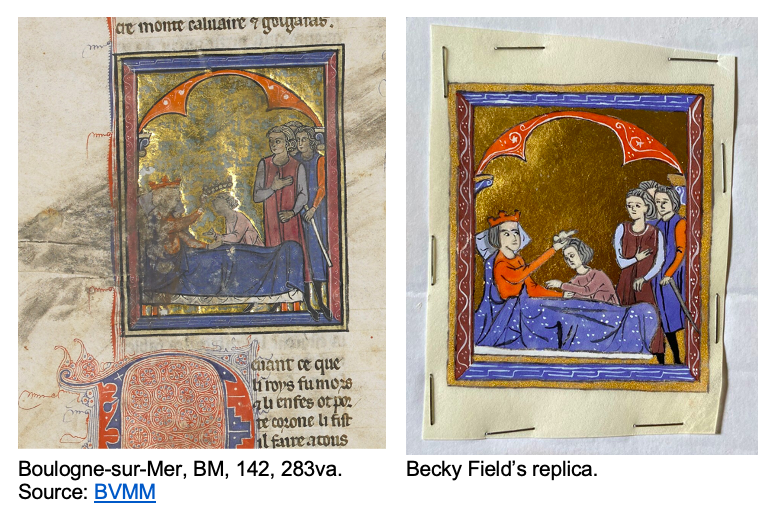
My aim was less to recreate the outcome of touching on the Boulogne miniature than it was to think through—and, crucially, experience the implications of—the questions its current material condition raised. Before starting our little experiment, I had six lines of enquiry in mind:
- Transference: What happens to the ink/pigment/gold when it is displaced?
- Precision: How precise can you be with a finger or fingernail?
- Moisture: To what extent is saliva needed to produce the desired effect?
- Heat: Is the warmth generated by friction important?
- Faciality: Do faces bear the traces of tactile interaction more visibly?
- Surface: What are the effects—both visual and haptic—on the parchment surface?
I began by doing what I think was relatively common among medieval readers: rubbing the face of an important figure. We see this, for instance, in the Boulogne manuscript on folio 32r.
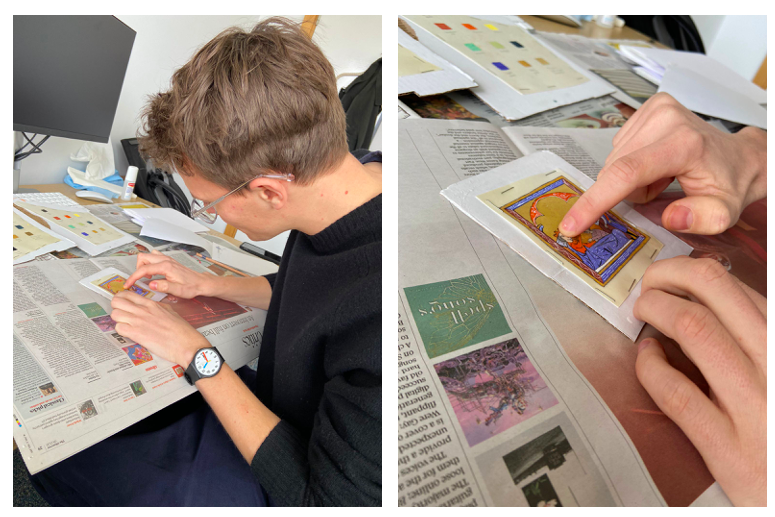
It’s worth mentioning that at first I found touching the miniature deeply wrong. It took some serious self-encouragement! But once that inhibition was overcome, it didn’t feel wrong at all. Becky and I were stunned straight away by how noisy the act of rubbing was. I had always envisaged it as being quiet, and this quietness associated it with a degree of privacy. On this new, almost sandpaper-like vellum, the sound was slightly scratchy and rasping. I didn’t find it pleasant. After a few minutes of quite forceful abrasion, I was surprised to see that the miniature had held up rather well. Some of the pigment was displaced (mostly onto my fingertip) and the gold background had partly come away, revealing the directionality of the hand motion. Generating the force needed to rub away requires a longer, and thus less precise, movement, which would suggest that a stronger touch manifests also in a more diffuse one (at least when human hands are involved).
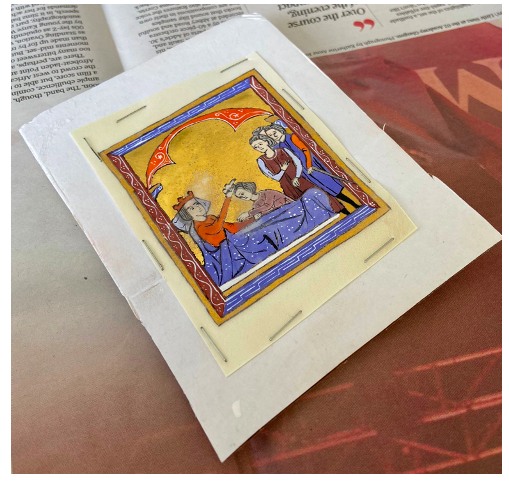
Still, I had expected the rubbing to be a more violent gesture than its effect on the miniature would have us believe. Perhaps, I then wondered, adding moisture would be more violent? Warning: this is gross. A negative LFT that morning, and a thorough handwashing shortly before, allowed me to repeat the process but with saliva. This felt profoundly weird. Yet, the impact on the painted standing figures on the right was instantaneous: the pigments, merging slightly, clung onto my fingertip, radically altering the appearance of the image. The facial outlines, which Becky had done in oak-gall ink, remained underneath, creating a somewhat ghostly effect.
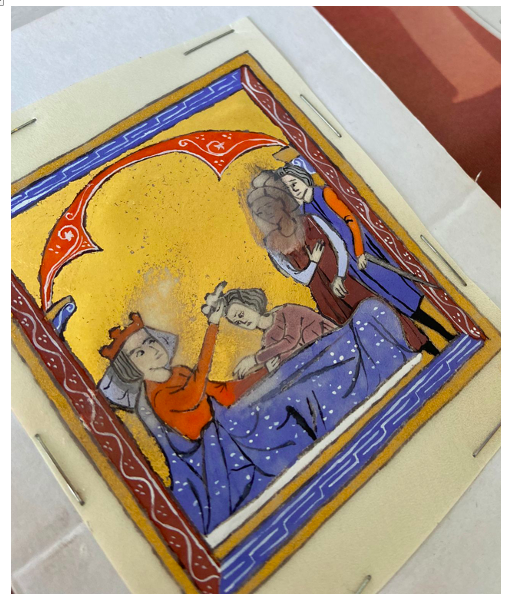
Given how quickly the moisture acted on the paint, there was much less collateral damage to the surrounding area. Surprisingly, the ‘wet’ abrasion (apologies!) resulted in a cleaner line than its ‘dry’ equivalent. This result instantly reminded me of a manuscript illumination I have examined before: the defacement of one of Julius Caesar’s assassins in the French prose biography of the Roman Emperor, the Faits des Romains (c. 1213–14). This manuscript was produced in northern Italy, probably Genoa, around 1280–1300. Here, too, the oak-gall outline has lasted while the colour has been removed.
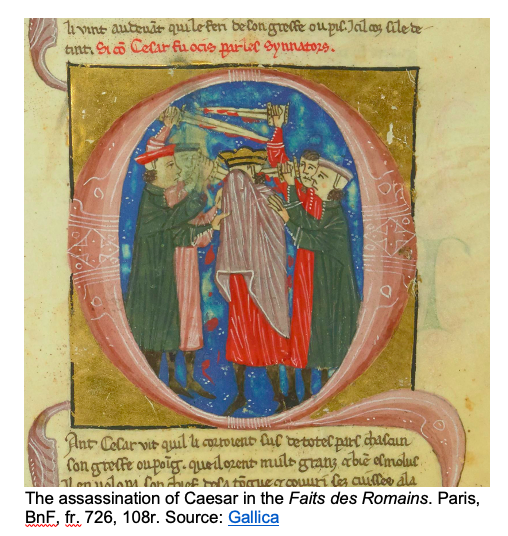
One lick of a finger, and poof, the offending senator’s memory has been damned for eternity! The manuscript prompted a handler to apply their bodily fluid to the book, presumably in service of an ethical judgement (disapproval of the betrayal, or at least the manner of its execution, against an unarmed Caesar). But given the haptic prominence of the scene—several hands are visible—and the flow of blood between the represented bodies, the reader’s intervention is also an act that, blending touch and viscous liquid, works on an imaginative continuum with the historical subject matter.
The Paris miniature also shows how the blue pigment is particularly vulnerable to human interaction. The final part of our experiment involved testing how different colours reacted to ‘dry’ and ‘wet’ abrasion. Here the effects were variable, and while ‘wet’ abrasion was, on the whole, more destructive, certain pigments held up better than others. Minium (orange) and woad (dark blue/indigo) were most resistant or repellent across both categories. Lapis lazuli (blue), orpiment (yellow), and malachite (turquoise-green) were highly vulnerable to both. Venetian red, verdigris (olive green), shell gold, and, to a lesser extent, lamp back and transfer gold did not move much through ‘dry’ abrasion, but did when moisture was added.
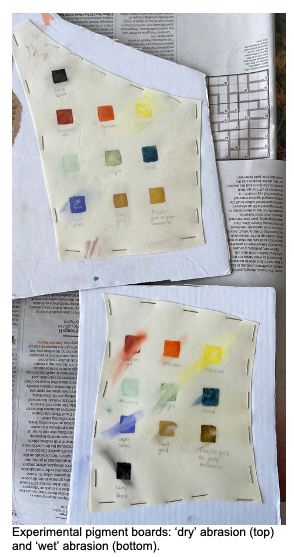
These observations, of course, lack any scientific rigour—and should be taken with a serious pinch of salt. The experiment did, however, make me reflect more carefully about the logistical dimensions of these haptic practices. It sounds obvious but touching the manuscript image in this way draws one’s attention to the artisanal processes that led to the book’s creation, the choice of pigments and their disposition on the page. The medieval book, as Elaine Treharne so wonderfully reminds us, was always experienced as a spatially-situated object. Applying the force needed to affect the surface of the manuscript image would have had a kinetic effect across the whole book, or otherwise would have required a second hand to keep the folio still. These holistic dimensions to book usage are sometimes hard to conceptualise through the digital screen, which makes the lessons of practice-based codicology all the more valuable.
If you have any comments, observations, or questions, please do get in touch: hr460@cam.ac.uk!
Dr. Henry Ravenhall, British Academy Postdoctoral Fellow in the Faculty of Modern and Medieval Languages, University of Cambridge
Bibliography
Jaroslav Folda, Crusader Manuscript Illumination at Saint-Jean-d’Acre, 1275-1291 (Princeton: Princeton University Press, 1976), pp. 184–85.
Kathryn M. Rudy, Piety in Pieces: How Medieval Readers Customized Their Manuscripts (Cambridge: Open Book Publishers, 2016).
Kathryn M. Rudy, ‘Kissing Images, Unfurling Rolls, Measuring Wounds, Sewing Badges and Carrying Talismans: Considering Some Harley Manuscripts through the Physical Rituals they Reveal’, Electronic British Library Journal, 3 (2011), 1–56.
Elaine Treharne, ‘Fleshing Out the Text: The Transcendent Manuscript in the Digital Age’, postmedieval: a journal of medieval cultural studies,4(2013), 465–78.
Elaine Treharne, Perceptions of Medieval Manuscripts: The Phenomenal Book (Oxford: Oxford University Press, 2021).
